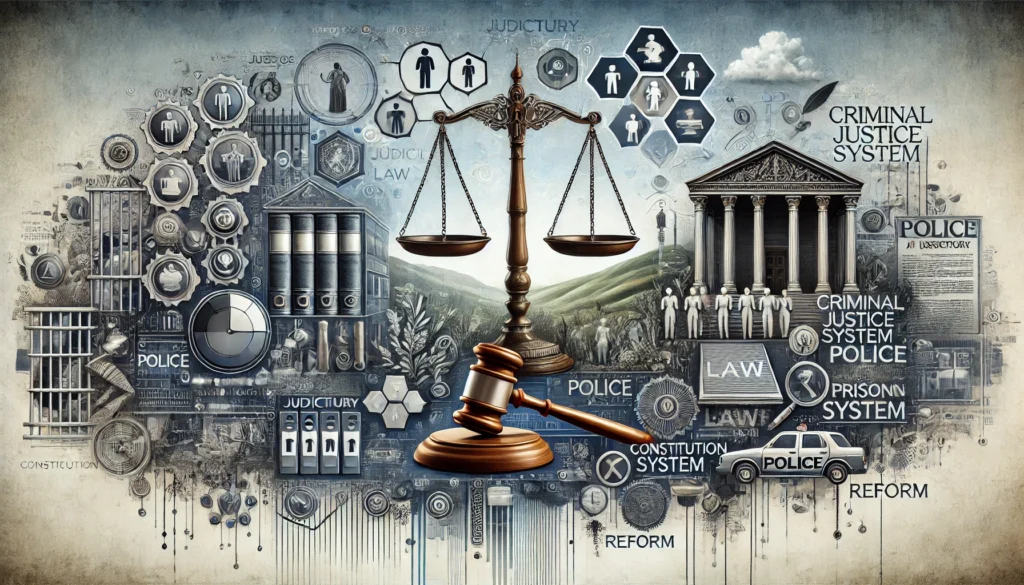Published on 15th August 2025
Authored By: Arihant Chatterjee
Sister Nivedita University, Newtown, Kolkata, West Bengal
Abstract
As a basic principle or rule we all know that an accused’s punishment must be in equal proportion to the punishment inflicted upon him. Being, an offender it doesn’t mean that a person should be punished twice or thrice for an offense committed by him which is not so serious in nature. Inflicting a less serious punishment for a serious offense is as bad as inflicting a more severe punishment for a less serious offense. Hence when such a situation arises when an offender is sentenced to a serve punishment [like capital punishment or life imprisonment]. Plea Bargaining comes to play its role in safeguarding the accused from any arbitrary punishment for any petty offenses. Apart from safeguarding the accused, the concept of plea bargaining has also helped in reducing the backlog of criminal cases pending before the courts, minimizing the number of under-trial prisoners. This legal article dealing with the topic of plea bargaining aims to cover all of its important aspects such as its meaning, background, aims, merits and demerits, procedure and most importantly its legal position as upheld in various landmark cases.
Keywords: Plea Bargaining, Background, Merits and Demerits, Procedure, Landmark Cases, Significance
Introduction
Plea bargaining can be defined as the method by which the accused and the state negotiate for reduced punishment and the accused accepts to plead guilty. It is a pre-trial process that allows parties to reach into a consensus and settle their case between themselves with the authority of the law. Therefore, it can be defined as an escape from a lengthy trial.[1]
In Indian law, plea bargaining is allowed only for specific offenses that carry seven years’ imprisonment and not for crimes against women, children, or other weaker sections otherwise. Plea bargaining is a voluntary exercise, and the prosecution as well as the accused have to agree to it before the court will entertain the plea bargain.[2]
If the plea bargain is accepted by the court, the defendant will have to plead guilty of the offence for which plea bargain has been decided and the court shall pass sentence upon him in accordance with the terms of the plea bargain. The defendant also relinquishes his right of appeal against the sentence or review of the conviction.[3]
Background
- The origin of plea bargaining can be traced back to USA where nearly 90 % of the cases are settled on the basis of plea bargaining. The practice of plea bargaining has been said to be rooted in the doctrines of ” Nolo Contendere “ which is a Latin term for ” I do not want to contest “. In India the practice of plea bargaining was not recognized by the courts and was held to be contrary to the public policy.
- In Murulidhar Meghraj Loya v. State of Maharashtra AIR 1976 [4]the court declared that it is best to hazard a guess about the virtue of criminal cases settled through negotiation particularly in the field of hazardous economic offenses and food offenses. This practice is contrary to public policy.
- In State of Uttar Pradesh v. Chandrika AIR 2000 [5]the court held that it is a settled principle of law that in terms of plea-bargaining court cannot dispose off criminal cases. Near acceptance or admission of the guilt should not be reason for mitigating sentences.
- But in view of the high pendency of cases and undue delay in disposal of criminal cases and on the recommendations of the Malimath Committee Report of 2003 the concept of plea bargaining was included in the Crpc in the year 2004 under chapter 21. And subsequently it was included in the BNSS 2023 under chapter 24.
Scope
The provision of plea-bargaining is not applicable in the following cases:
- a) Offense for which the maximum punishment is above 7 years.
- b) Offense committed against a woman or a child who is below 14 years of age.
- c) Where the accused had been previously convicted of the same offense.
- d) Offense which affects the socio – economic status of the country.
Aims and Objectives[6]
The aims and objectives of plea-bargaining can be listed below:
- It minimizes the load of the courts.
- It reduces the tendency of Indian courts to unnecessarily stretch criminal cases with any reasonable excuse.
- It plays an important role in minimizing the number of under-trial prisoners.
- It saves the accused from unnecessary harsh punishment for less serious offenses.
Merits and Demerits [7]
The merits and demerits of plea-bargaining can be listed as follows:
Merits:
- Rapid disposal of cases: The plea bargaining is beneficial to both the prosecution and defence as there is no risk of absolute loss in the trial. It assists the lawyers to defend their clients in a simple manner since both the parties hold bargaining power. In this way, the longstanding cases can be settled and the court would also not have to suffer encumbrance of case files.
- Less serious crimes on one’s record: In the case of a country like India, society plays an important role. After a person gets stigmatized by society, it becomes extremely hard for the individual to survive. Often stigmatization results in ostracization. In this situation, Plea Bargaining permits an individual to plead guilty or no contest in return for a decrease in the number of charges or the severity of the crimes. This leads to registration of less heinous crimes on the official court records of an accused. This proves beneficial to the accused when he is convicted later on.
- A problem-free method: Indian has a notorious record of having a long-pending case. Most cases proceedings take 8-10 years hence both the parties lose. There have been cases where accused were in jail longer than the maximum sentence for which he was charged. Such cases reveal a serious violation of their human rights. Plea bargaining enables a defendant to plead guilty without retaining a lawyer. But if they delayed proceeding to trial, they would need to locate and hire an attorney, and in the process, they must spend at least some time with the lawyer preparing for trial and paying the lawyer.
- It saves publicity: Plea Bargaining is also a good tool to save publicity since the longer the case runs the more publicity the accused receives. Therefore, plea bargaining avoids such publicity through a rapid disposal of the case. Celebrities and common individuals who earn their livelihood based on their reputation in the society, and those individuals who do not desire any undesired stigmatization. Even though the news of the plea itself may be publicized yet it remains only for a short duration compared to news of trial.
Demerits:
- Voluntarily adopted method: According to the legal provision regarding plea bargaining it is a voluntary method which is only considered when an accused chooses it voluntarily. But law is quiet on the aspect that if in case, the compromise arrived at is against the objective of the judicial system.
- Police Role: Police role in plea bargaining also builds criticism. India is notorious for police custodial torture. In such a situation, the plea-bargaining concept is more prone to enhance the situation.
- Corruption: The victim’s role in the plea-bargaining process is also not valued. The victim’s role in this process would invite corruption which is finally negating the purpose which is sought to be served by such act.
- Independent Judicial Authority: Plea bargaining provisions do not make provision for an independent judicial authority to consider plea bargaining applications. This is among the glaring reasons why it is criticized.
Procedure of Plea bargaining [8]
The steps or procedure of a plea-bargaining process can be summarized as follows:
- Under the Indian legal system, the facility of plea bargaining is provided in cases where the offense is punishable with imprisonment for a term of seven years or less.The accused individual should voluntarily choose plea bargaining, and the court should be convinced that the plea has been submitted voluntarily and with complete awareness of its implications.
- Plea bargaining can occur at any point in the criminal justice process, right from the first charge to the trial stage.The procedure of plea bargaining in India is started by the accused by presenting an application to the court stating his willingness to plead guilty.The court shall consider the application and may grant or refuse it subject to the facts and circumstances of the case.
- If the court grants the application, it will pass the case to the prosecutor to negotiate further.Through the process of negotiations, the prosecutor can tender a lesser sentence or other indulgence for the accused’s guilty plea.The accused can either accept or decline the offer and, if accepted, the court will enter the plea of guilt and impose the sentence as agreed under the plea-bargaining agreement.
- Additionally, if the accused breaches the terms of the plea-bargaining agreement, the court will declare the agreement void and proceed with the trial. The court can accept or refuse the plea-bargaining agreement when it considers that the agreement is unjust, unreasonable, or against the interest of justice.
- The accused may withdraw the plea at any time before the court imposes the sentence. If the plea is retracted, the trial proceeds as if the procedure of plea-bargaining had not taken place. Upon the imposition of the sentence, the sentence becomes final, and the accused cannot appeal against it except on the grounds of evident injustice.
Landmark Cases
The issue of plea-bargaining has been highlighted in the following landmark cases:
- Sukesh Behl v. Union of India (2018)[9]: In this case, the Delhi High Court observed that plea bargaining is an important tool to expedite the disposal of cases and provide a chance to the accused to avoid lengthy trials. The court asserted the necessity for the effective enforcement of its provisions and directed the government to start efforts towards making it aware to the stakeholders.[10]
- State of Rajasthan v. Shambhu Kewat (2014)[11]: In this, the Supreme Court interpreted the ambit and applicability of its provisions in India. The court held that plea bargaining is directed to grant a just and speedy trial, and in those cases which are eligible, it should be applied considering facts and circumstances of a case.[12]
- Raju v. State of Maharashtra (2013)[13]: In this 2013 case, the Bombay High Court declared that plea bargaining is not an alternative to a fair trial and that the courts should make it a point to see that the accused is not forced or coerced into accepting a plea bargain. The court also placed specific emphasis on considering the opinions of the victim about the plea bargain and making sure they are reasonably compensated.[14]
- State of Gujarat v. Natwar Harchandji Thakor (2005)[15]: In this case in 2005, the Supreme Court ruled that plea bargaining is not a right but a privilege bestowed by the state on the accused. The court also opined that plea bargaining is not appropriate in the case of serious offenses, and courts must use extreme caution in sanctioning plea bargains in the case of serious offenses.[16]
- State of Uttar Pradesh v. Chandrika (2000)[17]: In this 2000 case, the Supreme Court of India held that plea bargaining is a useful element in the criminal justice system, and it can be utilized as a useful tool to reduce the workload of courts and result in faster and efficient disposal of cases. The court also emphasized the need to make sure that plea bargains need to be voluntary and with full knowledge of the consequences.[18]
Significance [19]
The significance of the plea-bargaining process in the Indian criminal system can be illustrated in the following points:
- Plea bargaining shortens the duration in the settlement of cases in courts to the benefit of both prosecution and defence. It minimizes the risk of flat loss in a court case and lessens the burden on the judiciary. By speeding up the settlement of cases, courts can conserve time for more complicated legal cases.
- Plea bargaining in India provides one with an option to plead guilty for lesser offenses, considering the immense effect of social stigma on the life of a person. It implies a lesser offense on one’s record, perhaps decreasing the impact if they are again guilty of an offense later in life. Indian court trials are long, infringing on the rights of others, particularly when the accused is held in prison longer than the duration of the alleged crime.
- Plea bargaining is quick and effective that does away with the necessity of lengthy legal counsel, thus easing the stress and financial burden that comes with a lengthy trial. Prolonged legal hearings tend to attract undesirable public scrutiny.
- Plea bargaining accelerates case resolution, and this results in minimal publicity. This comes in handy with individuals whose reputation is important to their career or those who want to escape public scrutiny and censure.
- Although plea bargains can be made public, they receive less media coverage and a shorter news cycle than trials.
Conclusion
Plea bargaining is a judicial process whereby the prosecution and the accused bargain on how criminal cases are to be disposed off. It can be an effective means for mitigating the workload of courts and expeditious and effective disposal of cases. But care should be taken to see that plea bargains are voluntary and with full awareness of the implication, and the rights of the accused are safeguarded at all stages.[20] The Supreme Court in its landmark judgements from time to time had and again criticized against the plea bargaining saying that negotiations in the criminal cases are not allowed. But since the plea bargaining enables easy, inexpensive and speedy justice by settlement of disputes, including trial of criminal cases and keeping in view the current realistic picture of the pendency and delay in disposal of the criminal cases, the government found it feasible and ultimately brought it into being.[21] In general, plea bargaining is an extremely useful asset to the justice system, though it should be handled carefully and in a manner that advances justice and safeguards the rights of all concerned. Courts and legal practitioners should continue to keep the use of plea bargaining under surveillance and scrutiny to ensure it is being applied in the best and most equitable fashion possible.[22]
References
[1] Aakansha Singh, “What is Plea Bargaining?”, Divah Sprik Law Notes (2024), https://www.divahspriklawnotes.in/single-post/what-is-plea-bargaining (last visited June 21, 2025).
[2] Aishwarya Sandeep, What Do You Understand by Plea Bargaining? https://aishwaryasandeep.in/what-do-understand-by-plea-bargaining/ (last visited 21, 2025).
[3] Aishwarya Sandeep, What Do You Understand by Plea Bargaining? https://aishwaryasandeep.in/what-do-understand-by-plea-bargaining/ (last visited June 21, 2025).
[4] Murulidhar Meghraj Loya v. State of Maharashtra AIR 1976 SC 1929.
[5] State of Uttar Pradesh v. Chandrika AIR 2000 SC 164.
[6] Aakansha Singh, “What is Plea Bargaining?”, Divah Sprik Law Notes (2024), https://www.divahspriklawnotes.in/single-post/what-is-plea-bargaining (last visited June 21, 2025).
[7] Tripaksha Litigation, Indian Context of Plea Bargaining https://tripakshalitigation.com/indian-context-of-plea-bargaining/ (last visited June 21, 2025).
[8] Vajiram & Ravi, “Plea Bargaining,” Vajiram & Ravi Current Affairs (June 2025) https://vajiramandravi.com/current-affairs/plea-bargaining/ (last visited June 21, 2025).
[9] Sukesh Behl v. Union of India (2018).
[10] Xperts Legal, Concept of Plea Bargaining https://xpertslegal.com/blog/concept-of-plea-bargaining/ (last visited June 21, 2025).
[11]State of Rajasthan v. Shambhu Kewat (2014) 4SCC 149.
[12] Xperts Legal, Concept of Plea Bargaining https://xpertslegal.com/blog/concept-of-plea-bargaining/ (last visited June 21, 2025).
[13] Raju v. State of Maharashtra (2013) 14SCC 269.
[14]Aishwarya Sandeep, What Do You Understand by Plea Bargaining? https://aishwaryasandeep.in/what-do-understand-by-plea-bargaining/ (last visited 21, 2025).
[15] State of Gujarat v. Natwar Harchandji Thakor (2005) 1GLR 709.
[16] Aishwarya Sandeep, What Do You Understand by Plea Bargaining? https://aishwaryasandeep.in/what-do-understand-by-plea-bargaining/ (last visited 21, 2025).
[17] State of Uttar Pradesh v. Chandrika (2000) SC 164.
[18] Aishwarya Sandeep, What Do You Understand by Plea Bargaining? https://aishwaryasandeep.in/what-do-understand-by-plea-bargaining/ (last visited 21, 2025).
[19] Lawctopus, Plea Bargaining: Mechanism, Types, and Scope https://lawctopus.com/clatalogue/clat-pg/plea-bargaining-mechanism-types-scope/ (last visited June 21, 2025).
[20] Aishwarya Sandeep, What Do You Understand by Plea Bargaining? https://aishwaryasandeep.in/what-do-understand-by-plea-bargaining/ (last visited 21, 2025).
[21] Anisha Gupta, “Concept of Plea Bargaining in India: A Critical Analysis,” Law Finder https://www.lawfinderlive.com/Articles-1/Article9.htm (Last visited June 21, 2025).
[22] Aishwarya Sandeep, What Do You Understand by Plea Bargaining? https://aishwaryasandeep.in/what-do-understand-by-plea-bargaining/ (last visited 21, 2025).




